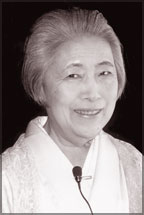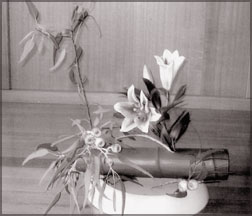Ikebana
Ikebana, one of the traditional arts of Japan, has been practiced for
more than 600 years. It developed from the Buddhist ritual of offering
flowers to the spirits of the dead.
|

Masumi Hiraga Jackson |
By the middle of the fifteenth century, with the emergence of the
first classical styles, Ikebana achieved the status of an art form
independent of its religious origins, though it continued to retain
strong symbolic and philosophical overtones. The first teachers and
students were priests and members of the nobility.
However, as time passed, many different schools arose, styles
changed, and Ikebana came to be practiced at all levels of Japanese
society. The beginning of Ikebana can be traced to the 6th century
introduction of Buddhism to the Japanese.

Part of the worship involved the offering of flowers on the altar in
honour of the Buddha. In India, the birthplace of Buddhism, the flowers
were placed very informally, and sometimes only petals were strewn
around. However, by the time of 10th century Japan, the Japanese were
presenting their offerings in containers. The altar offerings were the
responsibility of the priests of the temple.
The oldest school of Ikebana dates its beginnings from a priest of
the Rokkakudo Temple in Kyoto who was so expert in flower arrangements
that other priests sought him out for instruction. As he lived by the
side of a lake, for which the Japanese word is Ikenobo, the name Ikenobo
became attached to the priests there who specialized in these altar
arrangements.
Patterns and styles evolved so that by the late 15th century,
arrangements were common enough that they were appreciated by ordinary
people, not just the imperial family and its retainers.
Thus began the development of an art form with fixed requirements.
Texts were written, the oldest being Sendensho, a compilation covering
the years from 1443 to 1536. During the same period, noblemen and royal
retainers were doing large decorative rikka floral pieces.
Now Masumi Hiraga Jackson a qualified Master of 'Adachi School of
Ikebana' and an Executive Master of 'Ichiyo School of Ikebana' is here
to hold a demonstration on the art of Ikebana in collaboration with the
Japanese Embassy at the Auditorium of the Tourist Board on November 12
at 5 p.m. |
